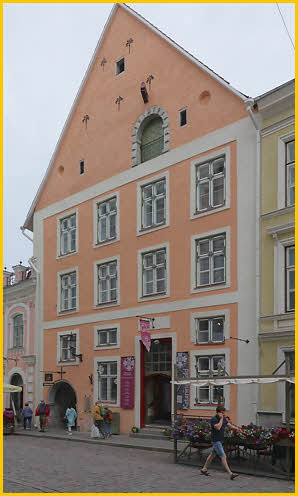Estonia
Entrance to
St Catherine's Passage
 |
Hidden between a 13th century church wall and a row of courtyards in the heart of Tallinn’s Old Town you will find the most enchanting passage connecting Vene Street and Müürivahe street. St. Catherine’s passage perfectly combines medieval ambiance with creative atmosphere brought to the passage by the artisan showrooms and workshops. This is easily the most picturesque street in Tallinn and although one has to put in a bit of effort to find it, it is most certainly worth a visit.
The medieval passage got its name from the adjacent St. Catherine’s Church, which was built by Dominican monks in the 13th century as part of a monastery complex. For a long time the passage was known as Monk’s Alley, but was renamed after the church was partly destroyed in the 16th century. The church is now in ruins, although part of the original facade still acts as the wall of St Catherine’s passage. Several large tombstones that used to be inside the church are now attached to the facades of the buildings on the other side of the passage. Both entrances to St Catherine’s Passage look more like entrances to courtyards (or even just house entrances), so one must really search to find it. You need to carefully watch the building facades while walking down Vene Street and make sure not to miss the passage’s gateway.
It is not certain if the buildings alongside the passage were originally a part of the St. Catherine’s Monastery complex or were all privately owned, but legend says that the monks had to make a very specific agreement with one of the neighbouring land owners to build the eight buttresses over the street that hold the wall of the church. The agreement stated that the church had to reconstruct the land owner’s courtyard and build a gate from her yard to the churchyard, and only then she would allow them to build the buttresses against her house. The passage has changed a lot over time; some of the original buildings from the 13th century remain and some have been renovated several times over. Other parts of the street were built over time up until the 16th century.
St Catherine’s Passage is a cosy and vibrant area, and it has always been a place where musicians, artists and craftsmen come together. In the summer of 1995 had a renaissance, after several artisans and merchants decided to unite and establish St. Catherine’s Guild. The Guild is an organization that includes 8 artesian studios and 14 artists. Here you can find artists creating and selling a wide range of arts and crafts. In the passage you will find studios dedicated to both traditional and modern Estonian design, and in various mediums such as, glass, ceramics, tableware and accessories, fine leatherwork goods, textile design and patchwork pieces, jewelry and hats. What makes this guild especially interesting is that it is comprised not only of store fronts, but also of workrooms for the artists, showrooms, galleries and workshops for aspiring and established artists. Most of these studios have open-plan set-ups where you can see the artists creating their works. Weather permitting, you can even find the artists and their students working on the street right outside the studios. The artists of the Guild have said that they have grown into one big family over time and they inspire each other every day. Both the locals and tourists in Tallinn like to visit St. Catherine’s Guild to enjoy traditional Estonian craftsmanship and to watch the talented artisans creating their outstanding pieces of art.
